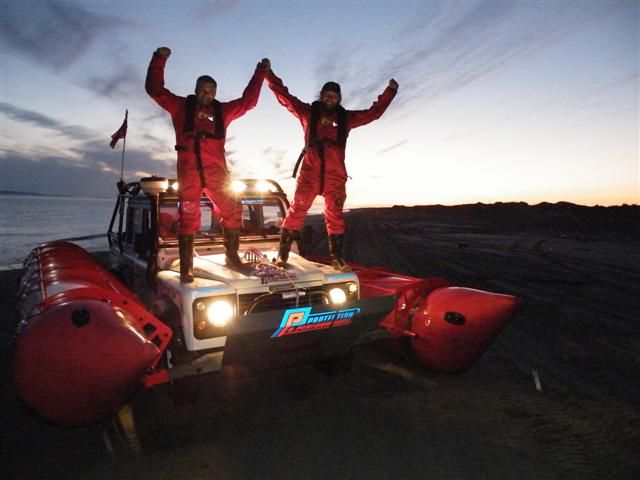Steve Burgess, a 53 year old British Angus Beef farmer, has triumphed where famed explorer Sir Ranulph Fiennes failed, by becoming the first person to cross the Bering Strait in a land vehicle. The trip began 10,379 miles away at his farm near Huddersfield in West Yorkshire and ended in Wales, Alaska. Using a Land Rover Defender->ke1858 fitted with a propeller and motor, he and his team drove from England, in the middle of winter, and then waited for the sea ice to thaw. The expedition was sponsored by the Cooper Tire and Rubber Company Europe, who provided Discoverer STT tires for the Land Rover’s land journeys.
To make the crossing, Burgess and his team had to conquer two big obstacles. The first was the strait which, at its narrowest point is 56 miles across, with unpredictable currents, icebergs and weather made it an intimidating prospect. Many previous attempts on the strait have focused on a winter crossing, including an unsuccessful one led by Sir Ranulph Fiennes in 2001. This was Burgess’s original intention. “But when I first visited the region in 2001,” he says, “it was obvious that any vehicle capable of getting across the ice wasn’t capable of getting to the ice, and so it would be impossible for one vehicle to make the whole journey.” The challenge was to adapt a road vehicle for a sea crossing.
The solution, developed by Protection & Performance, a company specializing in adapting 4x4s, was ingenious. Take a “rest-of-the-world”-spec Land Rover, which is less complex than the UK version, run an extra drive shaft out of the engine to power a propeller, and add floats. Enormous floats: the two red tanks that sit on either side of Burgess’s vehicle have a combined volume of 1,480 gallons and can maintain 5½ tons of buoyancy. Even stripped to the bare essentials and equipped with its two-man crew, the vehicle weighed three tons (a quarter of a ton of which was fuel). They also developed detachable caterpillar tracks to have the ability to cross snow and ice on the way to the strait.
Burgess left his farm on January 29 this year and reached Uelen, on the shores of the strait, on March 3. The final leg of the journey involved tracking the Arctic coastline of eastern Siberia for two weeks and enduring temperatures below -40C. On July 7, when weather permitted, the journey began. After 9 hours at sea the team was forced to stop on the little island of Little Diomede, population of 140, in the middle of the strait. The weather did not permit them to restart for another month, at which time it took them six and a half hours till they came ashore at a place called Wales, cheered on by the local population.

